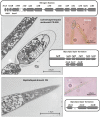The smallest known genomes of multicellular and toxic cyanobacteria: comparison, minimal gene sets for linked traits and the evolutionary implications
- PMID: 20169071
- PMCID: PMC2821919
- DOI: 10.1371/journal.pone.0009235
The smallest known genomes of multicellular and toxic cyanobacteria: comparison, minimal gene sets for linked traits and the evolutionary implications
Abstract
Cyanobacterial morphology is diverse, ranging from unicellular spheres or rods to multicellular structures such as colonies and filaments. Multicellular species represent an evolutionary strategy to differentiate and compartmentalize certain metabolic functions for reproduction and nitrogen (N(2)) fixation into specialized cell types (e.g. akinetes, heterocysts and diazocytes). Only a few filamentous, differentiated cyanobacterial species, with genome sizes over 5 Mb, have been sequenced. We sequenced the genomes of two strains of closely related filamentous cyanobacterial species to yield further insights into the molecular basis of the traits of N(2) fixation, filament formation and cell differentiation. Cylindrospermopsis raciborskii CS-505 is a cylindrospermopsin-producing strain from Australia, whereas Raphidiopsis brookii D9 from Brazil synthesizes neurotoxins associated with paralytic shellfish poisoning (PSP). Despite their different morphology, toxin composition and disjunct geographical distribution, these strains form a monophyletic group. With genome sizes of approximately 3.9 (CS-505) and 3.2 (D9) Mb, these are the smallest genomes described for free-living filamentous cyanobacteria. We observed remarkable gene order conservation (synteny) between these genomes despite the difference in repetitive element content, which accounts for most of the genome size difference between them. We show here that the strains share a specific set of 2539 genes with >90% average nucleotide identity. The fact that the CS-505 and D9 genomes are small and streamlined compared to those of other filamentous cyanobacterial species and the lack of the ability for heterocyst formation in strain D9 allowed us to define a core set of genes responsible for each trait in filamentous species. We presume that in strain D9 the ability to form proper heterocysts was secondarily lost together with N(2) fixation capacity. Further comparisons to all available cyanobacterial genomes covering almost the entire evolutionary branch revealed a common minimal gene set for each of these cyanobacterial traits.
Conflict of interest statement
Figures




Similar articles
-
Impact of nitrogen sources on gene expression and toxin production in the diazotroph Cylindrospermopsis raciborskii CS-505 and non-diazotroph Raphidiopsis brookii D9.Toxins (Basel). 2014 Jun 20;6(6):1896-915. doi: 10.3390/toxins6061896. Toxins (Basel). 2014. PMID: 24956074 Free PMC article.
-
Comparative genomics of Cylindrospermopsis raciborskii strains with differential toxicities.BMC Genomics. 2014 Jan 29;15:83. doi: 10.1186/1471-2164-15-83. BMC Genomics. 2014. PMID: 24476316 Free PMC article.
-
Reassessment of the toxin profile of Cylindrospermopsis raciborskii T3 and function of putative sulfotransferases in synthesis of sulfated and sulfonated PSP toxins.Toxicon. 2010 Dec;56(8):1350-61. doi: 10.1016/j.toxicon.2010.07.022. Epub 2010 Aug 6. Toxicon. 2010. PMID: 20692275
-
Compartmentalized function through cell differentiation in filamentous cyanobacteria.Nat Rev Microbiol. 2010 Jan;8(1):39-50. doi: 10.1038/nrmicro2242. Nat Rev Microbiol. 2010. PMID: 19966815 Review.
-
Cyanobacterial ultrastructure in light of genomic sequence data.Photosynth Res. 2016 Aug;129(2):147-57. doi: 10.1007/s11120-016-0286-2. Epub 2016 Jun 25. Photosynth Res. 2016. PMID: 27344651 Review.
Cited by
-
Progress in understanding harmful algal blooms: paradigm shifts and new technologies for research, monitoring, and management.Ann Rev Mar Sci. 2012;4:143-76. doi: 10.1146/annurev-marine-120308-081121. Ann Rev Mar Sci. 2012. PMID: 22457972 Free PMC article. Review.
-
Hassallidins, antifungal glycolipopeptides, are widespread among cyanobacteria and are the end-product of a nonribosomal pathway.Proc Natl Acad Sci U S A. 2014 May 6;111(18):E1909-17. doi: 10.1073/pnas.1320913111. Epub 2014 Apr 17. Proc Natl Acad Sci U S A. 2014. PMID: 24742428 Free PMC article.
-
Effects of PatU3 Peptides on Cell Size and Heterocyst Frequency of Anabaena sp. Strain PCC 7120.J Bacteriol. 2021 Jun 8;203(13):e0010821. doi: 10.1128/JB.00108-21. Epub 2021 Jun 8. J Bacteriol. 2021. PMID: 33846118 Free PMC article.
-
Proteome and strain analysis of cyanobacterium Candidatus "Phormidium alkaliphilum" reveals traits for success in biotechnology.iScience. 2021 Nov 6;24(12):103405. doi: 10.1016/j.isci.2021.103405. eCollection 2021 Dec 17. iScience. 2021. PMID: 34877483 Free PMC article.
-
Comparative transcriptome analysis of a toxin-producing dinoflagellate Alexandrium catenella and its non-toxic mutant.Mar Drugs. 2014 Nov 24;12(11):5698-718. doi: 10.3390/md12115698. Mar Drugs. 2014. PMID: 25421324 Free PMC article.
References
-
- Des Marais DJ. EVOLUTION: When Did Photosynthesis Emerge on Earth? Science. 2000;289:1703–1705. - PubMed
-
- Sivonen K, Jones G. Cyanobacterial Toxins. In: Chorus I, Bartram J, editors. Toxic Cyanobacteria in Water: A guide to their public health consequences, monitoring and management. London: E & FN Spon; 1999. pp. 41–111.
-
- Swingley WD, Blankenship RE, Raymond J. Integrating markov clustering and molecular phylogenetics to reconstruct the cyanobacterial species tree from conserved protein families. Mol Biol Evol. 2008;25:643–654. - PubMed
Publication types
MeSH terms
Substances
LinkOut - more resources
Full Text Sources
Other Literature Sources
Molecular Biology Databases
Miscellaneous

